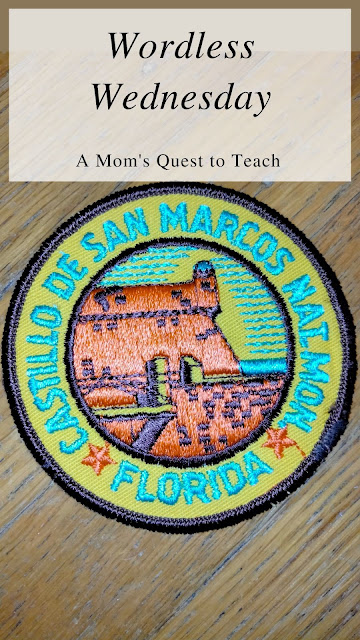A Mom's Quest to Teach is a regular column covering elements of teaching and learning (with an eye towards homeschooling), parenting, crafting, and all of the discoveries, joys, and daily roller coaster rides that occur while being a mom.
Wednesday, August 30, 2023
Wordless Wednesday: Patches from Canada
Tuesday, August 22, 2023
On a Journey for Homeschool Encouragement
One Step At a Time
I could have let everything overwhelm me. There were multiple possible outcomes. Give up for the day and say no school. Or we could delay our homeschooling plans and take it one step at a time.
Our younger children playing together with their toys encourages teamwork and cooperation. Or perhaps conflict resolution as they argue over character choices and decisions. Our teen learned that things do not always happen according to plan. He can also adapt and work during non-normal school hours. Changes and distractions don't have to be roadblocks to our homeschool lifestyle.
What Brings Me Encouragement?
At times, when things seem overwhelming, such as the years after my mom moved in with us and was diagnosed with dementia, it is easy to take a woe-is-me attitude. But there is so much encouragement to be found. Whether I seek that homeschool encouragement from fellow homeschool moms online or in person or I look to God, there are so many ways to make the journey a positive one.
Wednesday, August 16, 2023
Wordless Wednesday: Patches from Maryland/Washington D.C.
Tuesday, August 15, 2023
Bring Science to Life with Timberdoodle
I received a COMPLIMENTARY copy of this kit from Timberdoodle in exchange for my honest opinion. I was not required to write a positive review, nor was I compensated in any other way. This post contains affiliate links. Please see my Terms of Use and Disclosure Policy page for more information. Thank you.
Science is one of those homeschool subjects that I both love and dislike. When I can teach about animals, habitats, or nature, I am in my element. I worked for many years, both part-time and full-time, at a metropolitan zoo in the education department. But when it comes to the other areas of science, I often feel I am at a loss. So when I get the chance to use a kit to help teach science, it makes my homeschool day!
We have been using the Stepping into Science Kit, which is part of the Kindergarten Curriculum Kit from Timberdoodle. While we have a set science curriculum for both our second grader and our fourth grader, I love bringing science to life with additional experiments. This kit provides new ideas and experiments for relaxed summer homeschool days.
What is Part of the Stepping into Science Kit?
This science kit contains an experiment manual and 28 separate types of materials for the experiments. These experiments fall into five different categories:
- Experiments in Nature
- Experiments in Physics
- Experiments in Air
- Experiments in Water
- Experiments in Chemistry
Some of the experiments require items both in your house and ones that you might need to purchase, such as a scrap of wool or a house plant. Since you don't really need to complete the science experiments in any specific order, you can skip those if you don't have the materials.
A sampling of specific items in the science kit includes:
- garden cress seeds
- clay pot
- modeling clay
- small polystyrene soap boat
- funnel
A Look at Some of the Experiments
Experiment 1: The Cress Garden
Our daughter really enjoyed this first experiment. She took joy in making sure the cress seeds had water each day. We even did the experiment a second time where we set up two small plates - one with water and one without water to observe the differences.
Experiments 8 & 9: The Confetti Magnet and Salt and Pepper
These were fun experiments to look at electrostatic charge. We did need to reach out to a family member for a scrap of wool as we didn't have wool fabric in the house.
Experiments 15 & 16: Paper Airplanes
All three of our children enjoyed taking the paper airplanes outside to test. They discovered that one flew farther and faster than the other while testing them.
Experiments 24: The Soap Boat
Not all of the experiments worked out perfectly. When we tried to move the small boat by dipping the soap-tipped drinking straw into the water, nothing happened. We hypothesized that it was because our straw had a hole in it. We will be conducting this experiment again with a new straw. And then maybe with different soap to see if that makes a difference.
Our Thoughts
I always appreciate kits where everything is included. While I know that Stepping into Science can't include live plants or water, there were a few things that I wish had been included to make preparing the experiments easier. For example, finding a scrap of wool was not easy, and we haven't been able to find sugar cubes yet.
I thought the manual was very well-organized. I especially appreciate the kit contents with the photograph and list of all the items so I could check them off. And while I know that the manual was written to younger children, I wish there had been longer explanations for some of the experiments. Or maybe even an online resource so we could find out more information.
Our daughter and son both loved when I said it was time for science. And they are eagerly awaiting the completion of the rest of the experiments. Stepping into Science really helped bring science to life this summer.
I would recommend this kit to families with younger children (preschool-first grade). It is a great way to introduce experiments to children. It doesn't matter if you homeschool your children or not. You could easily complete a few experiments over the weekend to reinforce what your children are learning in their public, private, or homeschool lessons.
We still have experiments left! Which one should we try next?
- The floating paper clip
- Super soap bubbles
- Color detective
- Learn to Code in Your Homeschool
- Art History for All Ages: A Review of Have I Got a Story For You! Downloadable Art History Video Series (Renaissance)
- Dice, Decks, and Boards: Challenge Your Mind With Horse Academy
- Documenting Memories with Your Homeschooled Children: A Review of Me: A Compendium
Wednesday, August 9, 2023
Wordless Wednesday: Patches from Florida
Tuesday, August 1, 2023
An Out-of-this-World Homeschool Opportunity
This post contains affiliate links. Please see my Terms of Use and Disclosure Policy page for more information. Thank you.
When you think about homeschooling, what comes to mind? What are your concerns? Whether you have been homeschooling for years or you are new to the journey, you may have questions about curriculum, field trips, co-ops, and more. With different social media platforms and numerous websites, you are never far away from connecting with homeschoolers or finding answers to your questions. But what are those questions? And how can we provide our children with an out-of-the-world homeschool experience?
Common Questions Asked by Homeschoolers
1. What about socialization?
2. What is the best curriculum?
3. How do you grade assignments or courses?
4. How do you teach multiple grades?
Socialization and Making Friends
When people find out someone is homeschooling, they often want to know about socialization. How will the children make friends? But when you really think about it, when schools force children to be together in one classroom for the majority of the day, do they really get to socialize? Didn't we all have that one teacher who said, "You aren't here to socialize?" After all, school is supposed to be a place of learning, not talking and having fun.
If school is not for socialization, where do children make friends? Well, there are many places for children to find others with similar interests. There are sports teams that are not connected to public schools, homeschool co-ops, clubs through the library, and activities at church and with neighbors and family. Our homeschooled children can find friends in many places. And they will find friends of different ages and those that have lived different lives, since they are not only choosing from 30 kids in their classroom.
We can provide our homeschooled children with many out-of-the-box opportunities to allow them to meet new people and experience the world around them. They will gain the skills they need to interact with people of different ages, beliefs, ethnicities, etc., just by participating in daily life. What a beautiful way to introduce them to God's world!
Curriculum
What curriculum you choose will depend greatly upon your worldview, your children, your teaching methods, and your budget. There is a multitude of curriculum providers, from those who sell everything in one neat package to those who provide individual subjects, classes, or materials. Some families find it easier to purchase everything – math, language arts, history, science, etc. – from one company, while other families prefer to shop from among a variety of companies.
Over the past several years, we have found numerous curriculum companies and providers whose products work well for our children. We want to teach our children with a Biblical worldview, but I am not opposed to materials that are secular as long as they do not teach anything that goes against our faith.
Some of our favorite curricula or providers include:
- My Father's World: Studying God's Creation from A to Z: A Review of My Father's World Kindergarten Curriculum
- SchoolhouseTeachers.com
- Home School in the Woods
- CTCMath
- Memoria Press
Grading Opportunities
Depending upon which state you live in, your grading needs may be different from mine or someone else reading this post. You may need to keep graded assignments for each course, starting with elementary all the way through high school, or you may not need to worry about grades until you start recording them for a high school transcript.
If your curriculum comes with an answer key, then you are all set. You can use that to make corrections and then ensure your child understands the corrections. They should be able to fix their mistakes and apply the corrections to their next assignment. You don't want to just grade something and then file it away. Your child should use those graded assignments to study and make corrections in their own learning. You can also use them to help guide your lessons. If they don't understand the 4 times table, don't move on to the next math lesson until they do.
If there is no answer key, you will need to do more work as a parent with your child. What if they are writing an essay or research paper? You may have a rubric to help you grade the essay, but you may not be familiar with the subject material. So you may need to do some studying yourself or seek help from someone who knows the subject matter. Keep in mind that sometimes teachers assign topics that they are not super familiar with, and they still grade your children's papers. They are usually looking for a strong thesis, well-written paragraphs, and details that support their thesis. You can do the same!
Multiple Grades
The usual approach to schooling is to put children of certain ages together in grades. They get separated out based on their age, not on their ability. We don't need to do that as we homeschool. We can provide our children with an out-of-this-world learning opportunity. We can teach all our children at the same time. Their individual assignments may look different. They may be reading different books independently or working on a variety of math problems, but we can spend time learning together.
Our younger children are close in age and grade level, so we spend a lot of time learning together. In fact, we use our daughter's curriculum as our spine and then add in what we need for each of them. Since we sit together at the dining room table, they both listen in to each other's lessons at times and pick up new things even if they aren't studying that particular subject or topic. For example, our daughter has been introduced to multiplication as her brother studies it. She hasn't had official lessons on multiplication yet, but she will have a general understanding when we do start those lessons.
The easiest way to teach multiple grades together is to spend time reading aloud. You can read aloud history books, living fiction, science books, textbooks, the Bible, and more. Your children can work on independent work, color, draw, or play with quiet toys while you read aloud. Reading aloud gives you the opportunity to discuss what you are reading and share special time together as a family. Our read-aloud times are some of my favorite homeschooling times.
What Questions Do You Still Have?
We've looked at a few questions today that are common among new homeschoolers. What questions do you still have? Please ask in the comments.
.jpg)
.jpg)
.jpg)

.jpg)

.jpg)
.jpg)

%20(1).jpg)
.jpg)
.jpg)


.jpg)


